The haunted catacombs
Underneath the French Capital, there’s a network of tunnels and crypts. Is there something sinister lurking in the Catacombs of Paris?
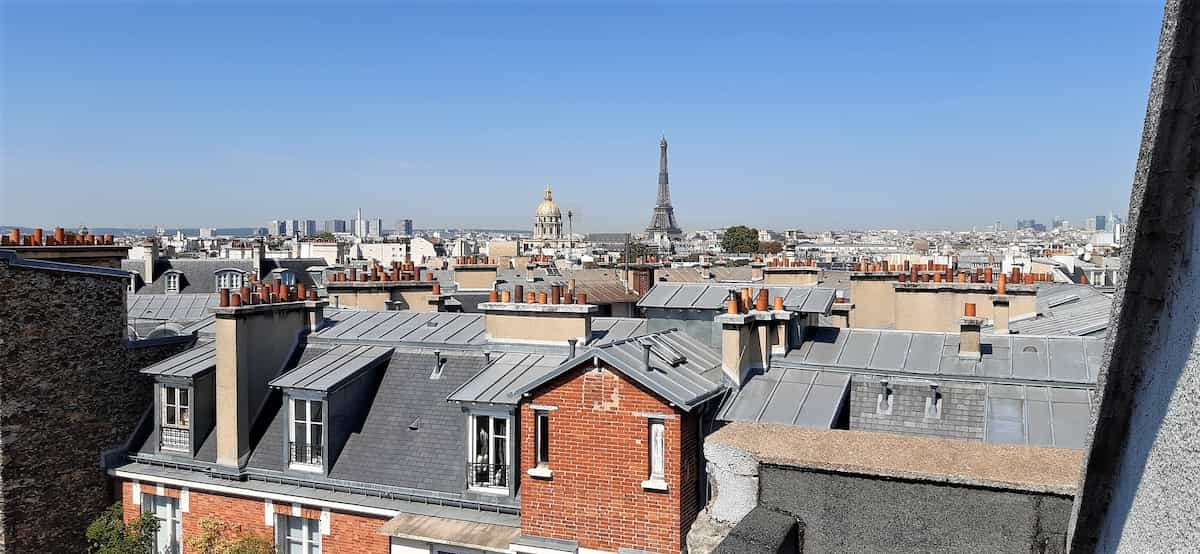
The haunted catacombs
Sometime in the late 1990s, the French freelance photographer and filmmaker, Francis Freedland, was contacted by an amateur cave explorer. The young man said he had something he wanted to show him urgently. When they got together, the photographer was confronted with a video cassette, containing footage from the famous Paris catacombs.
They sat down and started rolling the video. At first, nothing strange occurred on the screen. It’s filmed in first-person, subjective angle. You see the narrow corridors, every now and then interrupted by a doorway or a smaller passage to the right or to the left. The walls are hard soil, as is the floor. As he walks along, certain parts seem even more narrow, or lower in height. But it’s still nothing extraordinary or uncommon.
Francis was already aware of the fact that people sometimes go down there to explore. It’s forbidden and it’s dangerous, but he knew that sometimes the human race wants a bit more adrenaline than just going to work and coming back again.
The hunted explorer
He turned and was about to ask his companion what’s so special about the footage they were watching when the young adventurer signaled at him to watch…
– Look, he said… Watch this!
And suddenly the pace of the video increases a little. In front of Francis’s surprised gaze, he saw how the maker of the film down there in the underground accelerates. First, it’s hardly visible, but after a short while, you can hear that his breath is faster… Nervous. His steps become more irregular, and after a short while, he is running. The focus of the film moves up and down, left and right, and soon it’s so shaky that it becomes impossible to follow the course. The man is now running and panting heavily, faster and faster until he drops the camera. The video footage stops, framing the wall and a piece of the tunnel ahead from the floor, while the steps of the man seem to continue ahead in the darkness.
After that, the camera continues filming that static image until it runs out.
So what is the video showing? A man who’s panicking from not being able to find the way out? … Or did it show a glimpse of something more sinister? Something lurking deep down under the glamorous boutiques and large Avenues of the French Capital? Something that hunts whoever dares to enter his realm?
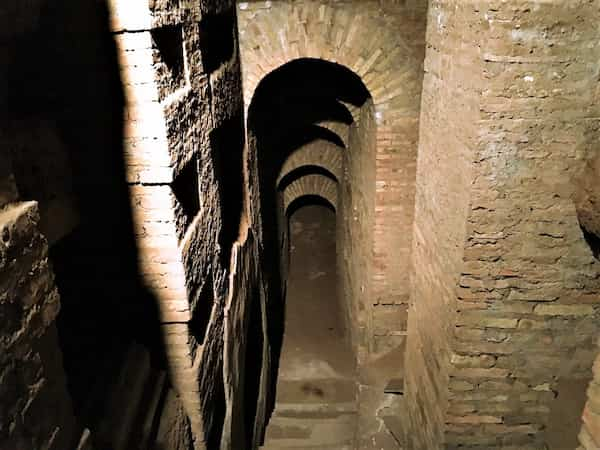
What are the catacombs?
Catacombs are tunnels, rooms, and chambers under the ground, originally used as burial places. The word, Catacomb, is of Greek origin, but the significance is uncertain.
The most famous are those in Rome, Italy. The oldest are in Paola near Valetta in Malta. But there are Catacombs in many places, especially in the Mediterranean area. Other famous catacombs are Paris, Kom El Shoqafa in Egypt, Odesa in Ukraine, and Brna in the Czech Republic.
Most can be visited by tourists, but only with guides, and in certain well-lit, restricted areas. Some are very big. The Odessa catacombs have a total length of more than 1500 miles.
And why were they built?
The ancient catacombs started out as burial places, like the ones under the eternal city of Rome, Italy. In the 2nd century, the first Christians started burying their dead underground. As a part of their beliefs, they couldn’t burn their diseased as the Pagans did, cause how were they supposed to present themselves after the final Armageddon if they didn’t have a body?
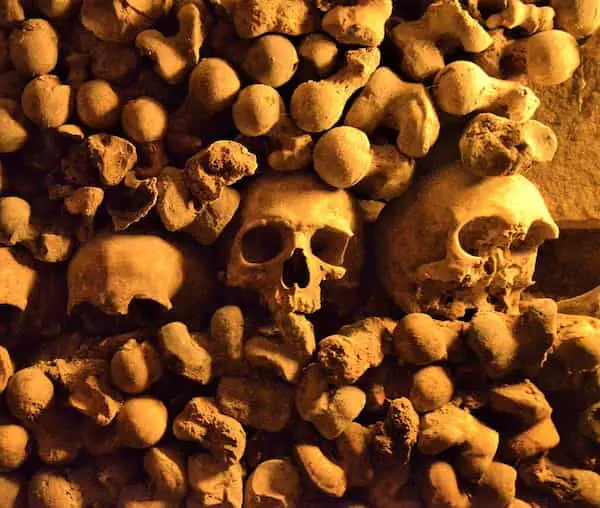
And as putting decaying corpses down into the ground inside the city walls was forbidden, for obvious reasons, their only alternative was to bury them outside the city walls. The churches were small, the cemeteries were limited, and the Romans didn’t care much for their religion anyway. Soon it became crowded around the temples, To resolve this, they started digging down into the ground to be able to put the bodies of their loved ones to rest… In the catacombs.
Myths about the catacombs in Rome.
That meant every church in Rome had its own burial cave underneath the churchyard. With time these became bigger, with more space and more graves. But they still had to respect the boundaries of the area of the site on top. They couldn’t dig out horizontally into the neighborhood. So, they dug down. Some corridors of the Roman catacombs are as high as 20 meters or more, all flanked by burial chambers.
- The catacombs in Rome are separated from each other. It’s not one big labyrinth.
- The catacombs in Rome were never hiding places for the Christians to evade the Roman oppressors. The Romans knew very well where they were, the entrances, and who was in charge. It was all perfectly legal, and official in every sense.
Other locations.
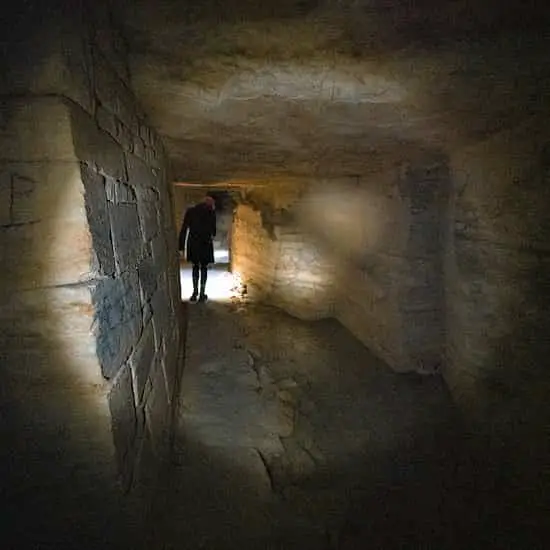
The same type of catacombs dug for the same reason, can be found all over Italy… And all over the Roman world, even further away than that. The idea of burying people in caves and tunnels underground lived on even until the 20th century. Rosalia Lombardo was the last person to be buried in the Capuchin Catacombs of Palermo in Sicily, Italy. She died in 1920, at only two years of age.
Other famous Catacombs can be found in Lima – Peru, in Vienna – Austria, in New York, in Bambang – the Philippines, and many other locations.
If we determine the catacombs as not necessarily and exclusively a final resting place, then the list grows significantly. In the US there are many underground structures to visit. In Beijing, China, there’s an underground network covering more than 30 square miles, constructed in the 1970s. Or just think about the vast Củ Chi tunnel network used by the Vietnamese soldiers during the Vietnamese war.
Be careful where you walk… There could be a void under you.
The haunted catacombs in Paris.
If the Roman catacombs are very old… Separated in many different networks, and reasonably tidy, well documented, and accessible… The Paris underground tunnels are very different. The mysterious video presented to Francis Freedland, couldn’t have been from Rome. The Roman catacombs are just too limited and well-lit.
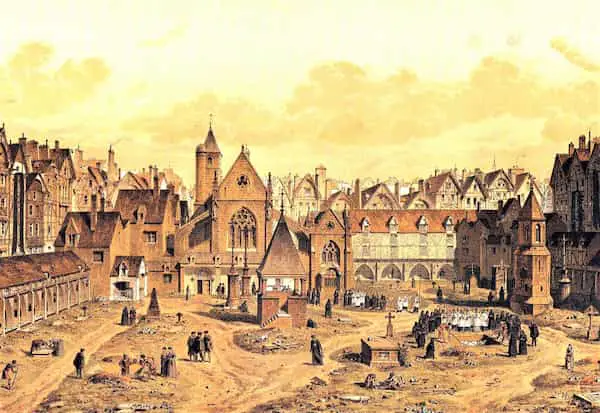
Under Paris, on the other hand, there’s an enormous spiderweb of corridors on five levels. Some parts are easily accessible, and you can go there with a tourist guide who tells you everything you need to know. But there are miles and miles of haunted catacombs that are much scarier, and much more dangerous… And they are much more recent than their Roman namesake.
The origin
In the late 1700, the authorities in France were becoming concerned about the overcrowded cemeteries in the Capital. The city was growing fast and all the corpses in and around the small cemeteries were becoming a severe health risk. The stench especially around the Holy Innocents’ Cemetery, the oldest and largest graveyard in Paris, was overwhelming. And when in 1774 a part of a basement wall collapsed under the weight of the many cadavers, spilling dead and decaying corpses all over the neighboring streets, something had to be done… And quickly. So Luigi XVI closed all cemeteries inside the city and started planning for the removal of the already buried to abandoned querries further away.
Not too far away though, just about outside the city gates, would be perfect. And the first and easiest spot to dump them was Barrière d’Enfer Gate of Hell, a tollgate, on the border of the city.
The quarries under the city.
Because in Paris, unlike in Rome, there was no need to dig. The tunnel system was already there in form of old Lutetian limestone quarries Most of the city was built of Lutetian limestone and all that material had been extracted from underneath the city, leaving a huge web of old mines, tunnels, and chambers.
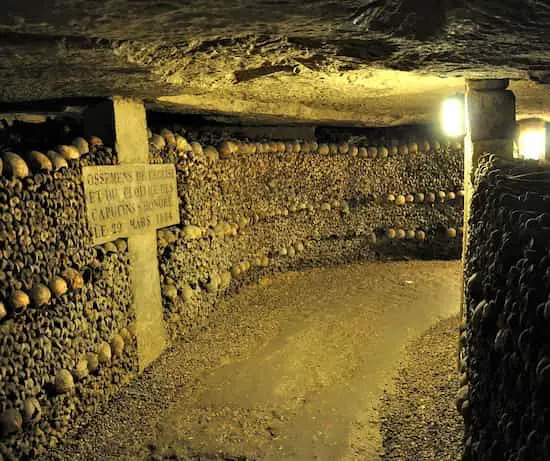
At first, they just dumped the bones, but from 1810 they started organizing and placing them in an arranged fashion. The enterprise was led by Inspector Héricart de Thury, who either had some macabre stylistic urge or was highly ironical. Anyway, he started building rooms, and chapels, and he arranged the bones and skulls in artistic patterns.
He practically created what is today a site that attracts half a million tourists a year.
The burial parts of the tunnel system, the ossuary, which is what attracts the visitors, is about a mile. One mile of corridors, rooms, and crypts, decorated with human remains in form of skulls, basins, and legbones.
But the total length of the haunted catacombs is supposed to be as much as 200 miles, maybe even more. Nobody knows. 200 miles of winding, dark corridors in five levels… Full of dead people, or even worse, maybe not entirely dead…
So are they really haunted?
While the haunted catacombs of Rome isn’t a common statement, the haunted catacombs of Paris definitely is. And it’s very easy to see the reason why. The Parisian network is scary. It’s huge, and it’s partly unmapped, so you can easily become trapped down there with the dead bodies and the skeletons. It’s a terrifying thought and not just a thought. Many people actually have met that fate, not being able to find their way out.
Philibert Aspairt was a doorkeeper of the Val-de-Grâce hospital. In 1793 for some reason he went down through a staircase located in the hospital courtyard. He was found 11 years later and could be identified only cause he still had the key to the hospital on him. He was buried on site.
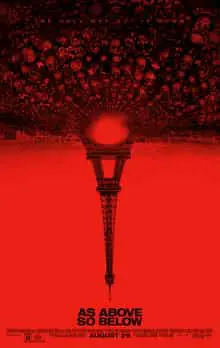 The movie… There’s always a movie…
The movie… There’s always a movie…
Two movies, actually. The first was Catacombs, directed by Tomm Coker and David Elliot and starring Shannyn Sossamon, released in 2007. The second was As Above, So Below, written and directed by John Erick Dowdle and starring François Civil and Perdita Weeks. Both created with lots of footage of narrow tunnels, dark shadows, deep pits, and scared teenagers. It’s effective.
There’s a very obvious pattern when it comes to hauntings. Any type of publicity, Tv, Movie, News, anything, boosts the general scariness of a place. And before the movies, there was the very famous TV-series, Scariest Places on Earth, Season 1, Episode 2 from 2000 hosted by Lind Blair.
And we’re back to where we started. Because Francis Freedland’s videotape formed the base for a part of that episode. Freedland together with the camera crew and a guide, went down into the tunnels to try to find the origin of the video film. And maybe find the exact spot from where it was shot.
To cut the story short, it is a frightening experience. But not because of any hauntings on spooky findings. The chill you feel when you watch the footage comes from a sense of claustrophobia. The narrow corridors, the low roof, the tight passages, and the panting voices… Well, you know the style. It’s kind of disturbing, but there’s no real substance.
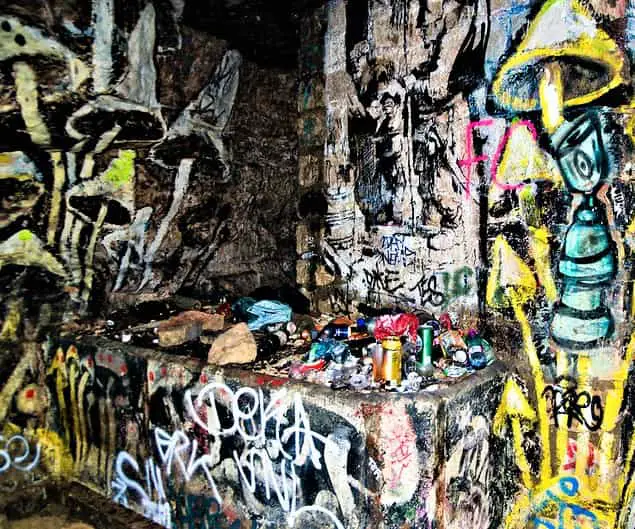
So, the haunted catacombs, it’s all a scam?
There are at least three strange facts about this video:
- Why on earth would anybody drop the camera? He could have been attacked but in that situation, he must have tried to do anything not to lose the only light source he had. Even if he was chased.
- The total of the film has never been made public. It is supposed to be around 40 minutes, but all we have ever seen is the last minute.
- The timing. Freedland states that the video was found in 1993, but the first evidence of it is from 2000 when Most haunted places on earth sent the episode. Why didn’t he go to the police? Why didn’t he try to investigate earlier?
And that leads us to the famous TV series. It is beyond any doubt that The most haunted places on earth on occasions created and invented facts to make a good show
More interesting facts about the haunted catacombs of Paris.

The whole city is constructed on top of a tunnel web that is reasonably superficial. This fact makes constructing heavy buildings somewhat risky. And Parisian law states that the owner of a property not only owns the surface but also what’s under it. So if the house collapses, you, yourself are responsible.
- The tunnels were originally outside the city gates, but as Paris grew, they became well inside the city limits. The biggest risks for sinkholes are therefore in the suburbs. The city center is regarded as safer.
- It’s estimated that there are remains from over six million people down there. That would mean that there are more dead than alive in Paris today.
- And the bones are still down there. While the skeletons of the Catacombs in Rome have been moved or stolen, the dead in Paris are all there… At least most of them.
- In 1880 an innovative French farmer found out that the Catacombs were perfect for growing mushrooms. A few years later more than 300 mushroom farms were set up down there, and the cultivation continues even today, but on a smaller scale. These are the famous Champignon de Paris.
- During WW2 the resistance used the catacombs for transport. Interestingly, so did the Germans. They even set up a large bunker right under Lycée Montaigne, one of Paris’ most famous schools. Fortunately, with both parties moving about in the 200 miles of tunnels, there was little risk that they would run into each other.
- In 2017 thieves drilled their way into a basement from the Catacombs straight underneath it. They got away with 300 bottles of vintage grand cru with a market value of more than 250.000 euros. The operation was meticulously planned and the bottles were never found again.
Although most people would avoid the forbidden and haunted catacombs, there is a community of adventurers, the so-called Cataphiles. These are to a certain degree experts in where to enter, how to behave once down there, and, most important of all, how to exit the catacombs. It is a very secret community with no names or identities and with a fixed, and determined conduct.
Among those, there’s an even more secret group called…
Les UX
Their goal is to explore, restore, and improve hidden corners of Paris. They frequently go into the Catacombs and they are responsible for many extraordinary features. And they’re not only young hipsters, and yuccies, but also more prominent and older members of society… Architects historians, and entrepreneurs. Here are a few examples:
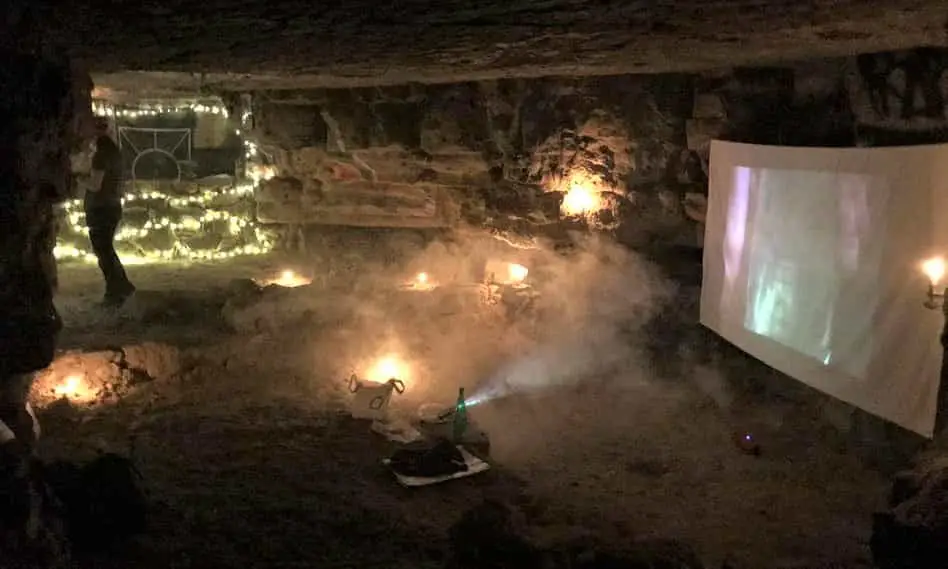
In 1981 the group stole the complete mapping of the catacombs from the ministry of telecommunication. And from there they’ve managed to pull off a long list of amazing endeavors. They are not only a nuisance to the authorities but they actually fix things too.
In 2007, they restored the famous clock in the Panthéon together with the clockmaker Jean-Baptiste Viot.
2004 the Police discovered a complete movie theater underground. Complete with a bar, a kitchen, and seats carved out of the rock. They had pulled electricity from the surface and even had a motion-detecting CCTV setup that triggered recorded dogs barking if someone would close in on their hideout. When the police came back after three days all they found was a note saying “Don’t search for us”. All the equipment was gone.
So, in the end, where does it leave us? Are the catacombs underneath Paris haunted or not?
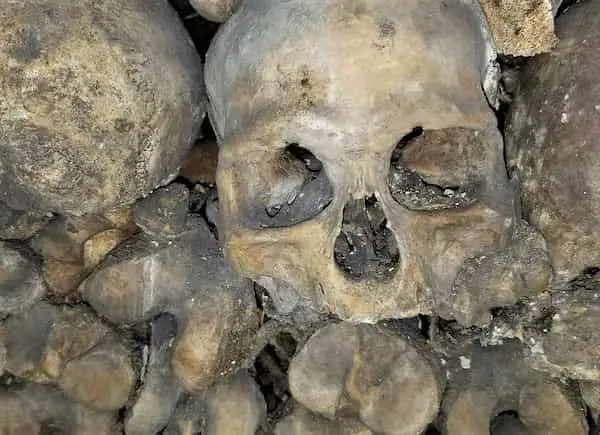
No, they’re not. Francis Freedland’s video clip is probably a fake… Done by him, by someone else in Paris. But probably by the creators of Most haunted places on earth. They did these things, you know.
And for the rest, there is no indication whatsoever that anything sinister or ghostly happens down there.
But it’s still creepy. And the creepiness obviously comes from the fact that the not so haunted catacombs of Paris are vast. Even though people move around down there, the graffiti on the walls is a good testimony of that… There still are 200 miles of tunnels to get lost in. 200 miles of dark, damp, narrow, rough, and largely unmapped tunnels, in five layers down all the way to 100 feet under the surface. And they are full of human bones. If that’s not scary… I don’t know what is.
Conclusion.
No, the Catacombs under Paris aren’t haunted. But they can be very frightening, even life threatening, all the same.

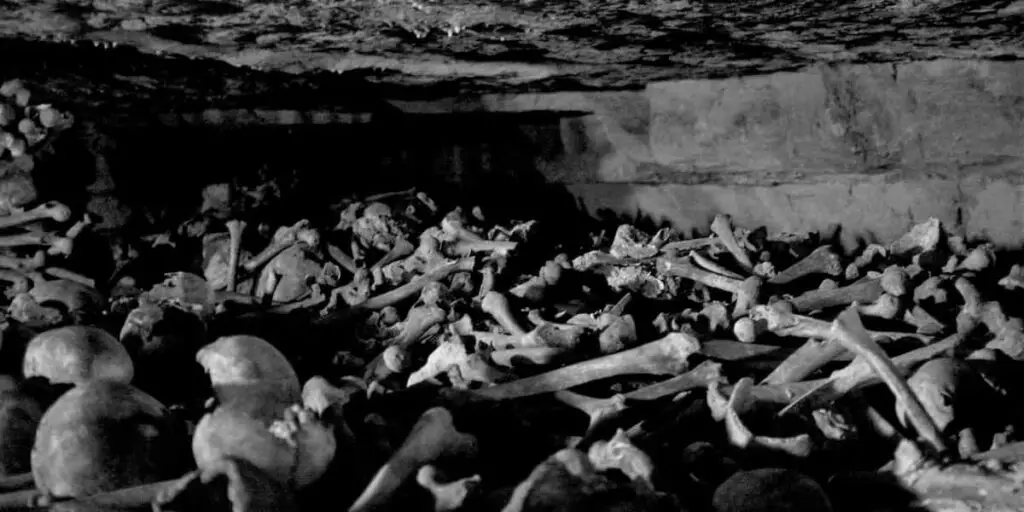
sources